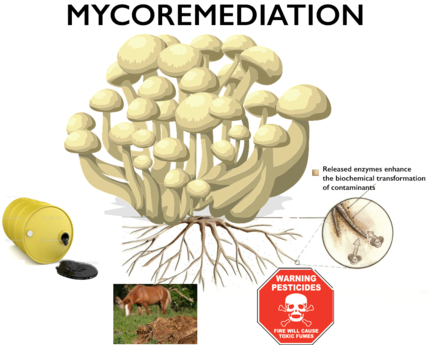Over the next few weeks, the mushrooms produced spores and died. They are often recalcitant to degradation and in some cases, like some azo dyes , cancerogenic or otherwise toxic. Have you ever been told to chew before you swallow? Okay, so not exactly fun, really more like hard, necessary, ecosystem-saving work. Due to high degree of toxicity leading to health effects such as multiple organ failure and carcinogenic effects, heavy metals; arsenic, cadmium, chromium, lead, and mercury are considered as priority metals which need to be removed from environment in order to reduce their impact on public health and environment. 
| Uploader: | Mut |
| Date Added: | 5 November 2013 |
| File Size: | 21.44 Mb |
| Operating Systems: | Windows NT/2000/XP/2003/2003/7/8/10 MacOS 10/X |
| Downloads: | 97395 |
| Price: | Free* [*Free Regsitration Required] |
Watch 5 minute video clips, get step by step explanations, take practice quizzes and tests to master any topic. The genome analysis of fungi is helpful in tracing such genes like pcs and studying their evolutionary aspects [ ]. Bioconversion of waste Remarks References 1 Pleurotus citrinopileatus Handmade paper and cardboard industrial waste Successfully cultivated.
The toxicity of chemicals used in dyeing industries is manifested in the form of decreased carbohydrate, protein and chlorophyll and increased proline content in exposed plants in addition to reduction in the rate of seed germination and growth of crop plants [ 7172 ]. Endocrine disrupting chemicals EDCs and TrOCs such as pharmaceuticals and personal care products PPCPs which can result in effects such as bioaccumulation, acute and chronic toxicity to aquatic organisms, and possible adverse effects on human health have generated a lot of interest with reference to their degradation by white-rot fungi.
The most important parameters to define a contaminated site are: Environmentally acceptable management of kitchen waste residues by using them as substrates for the co-production of a cocktail of fungal carbohydrases.

Fungal Degradation of Pesticides. Other toxins fungi are able to degrade into harmless compounds include petroleum fuels[31] phenols in wastewater, [32] polychlorinated biphenyl PCB in contaminated soils using Pleurotus ostreatus[33] polyurethane in aerobic and fuhgal conditions such as found at the bottom of landfills using two species of the Ecuadorian fungus Pestalotiopsis[34] and more.
Mycoremediation
Toxicity reduction is also dependent on the substrate. The resistance of textile dyes to fading on exposure to sunlight, water, and their persistence in environment due to synthetic origin is a cause for concern owing to their toxicity Verma et al.

The wide-scale distribution of heavy metals in the environment owing to their application in multiple areas is a cause for concern due to their systemic toxicity to human health even at low concentrations. Fungi, thanks to their non-specific enzymes, are able to break down many kinds of substances. Bioremediation of a crude oil polluted soil with Pleurotus Pulmonarius and Glomus Mosseae using Amaranthus Hybridus as a test plant.
It is the process which leads to complete mineralization of the starting compound to simpler ones like CO 2H 2 O, NO 3 and other inorganic compounds by living organisms.
Tutoring Solution High School Physics: Many of these contaminants do not lend themselves to bacterial degradation because of distinctly xenobiotic structures.
These enzymes can be used for hydrolyzing the polymeric substances such as cellulose, xylan, starch, protein, and lipid present in wastes including food, kitchen, vegetable market, leaf litter etc. Other applications of such fungi have been targeted at overcoming technical barriers of algal bio-fuels and photosynthetic biorefineries by mycoremediatiln of bkoremediation and fungi for the complete removal of single algal cells from fermentation medium.
Action of other nonspecific extracellular enzymes was responsible for providing degradation ability to several fungi for explosives such as TNT in presence of co-substrates bioremfdiation cellulose and lignin [ 8 ]. This latter [Trichoderma harzianum strain] hyperaccumulates up to 11, mg Ni kg-1, suggesting its possible use in a bioremediation protocol able to provide a sustainable reclamation of broad contaminated areas.
Create an account to start this course today.
Diverse Metabolic Capacities of Fungi for Bioremediation
For instance, a fungal strain, Byssochlamys nivea can grow on pentachlorophenol-contaminated soil samples, however, its benefit to humankind is limited due to lack of reference genomic data providing information on biochemical processes.
Fungi have been proven to be a very cheap, effective and environmentally sound way for helping to remove a wide array of toxins from damaged environments or wastewater. Abstract Mushroom has been used for consumption as product for a long time due to their flavor and richness in protein.
Overview of the bioremediation and the degradation pathways of DDT. Degradation and transformation of anthracene by white-rot fungus Armillaria sp.
Log in or fyngal up to add this lesson to a Custom Course. Population and the Environment Email Parent account email Email is required. The non-specific nature of their activity on a variety of substrates makes them ideal catalyst for different industrial applications bioremediztion which these enzymes have been extensively explored for their efficient bioremediation potential [ ].
Successfully convert this waste and qualitative and quantitative changes were also measured. You'll use this email to administer your student accounts. Biosorption techniques are now becoming very popular for the removal of pollutants.
Gamma irradiation in modulating cadmium bioremediation potential of Aspergillus sp. Aspergillus niger recorded maximum decolorization of the dye Basic fuchsin

No comments:
Post a Comment